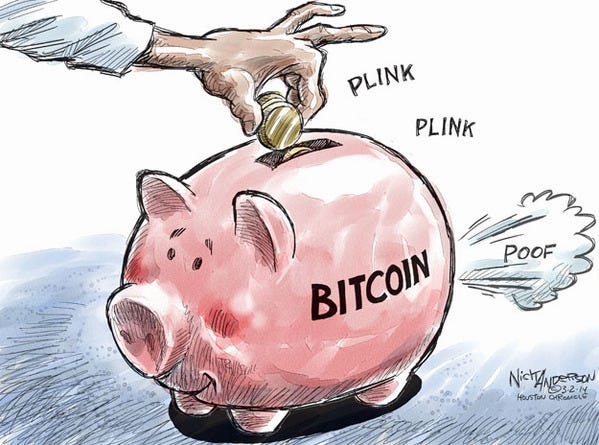Why You Should Allocate 5% of Your Portfolio into Bitcoin
Welcome to this week’s edition of the Myth of Money, a weekly newsletter on all things money, economics and technology read by 10,000+ subscribers, curated by Tatiana Koffman.
Disclaimer: The following is not intended as investment advice. Do your own research.
This week was incredibly bullish for Bitcoin.
Following on the heels of earlier news of MicroStrategy investing $425 million of their treasury into Bitcoin, and Jack Dorsey following suit with $50 million of Square’s treasury, Stone Ridge Asset Management announced a purchase of 10,000 Bitcoins ($115 million) as part of their capital management strategy.
While Bitcoin’s price continued to recover, Grayscale secured a whopping $1 billion in new investment for its Bitcoin trust in Q3 alone.
What is driving this sudden institutional in interest in Bitcoin? There are 3 main factors to consider:
Interest Rates - with interest rates remaining at 0% for the foreseeable future, bonds and treasuries are not longer a viable low-risk investment alternative
Inflation - the Federal Reserve has made its intent clear to keep pushing inflation upwards and while the Treasury will continue to increase the monetary supply with additional stimulus
Geopolitical Instability - as political tensions rise between U.S. and China, and the Dollar’s reserve currency status is increasingly questioned, holding USD-denominated assets poses an inherent risk
Fidelity Digital Assets published a detailed report, recommending a Bitcoin portfolio allocation of approximately 5% to Bitcoin. Fidelity presents the following arguments for Bitcoin to take place alongside other alternative investments in your portfolio.

What are alternative investments?
The broadest classification of an alternative investment is anything that is not a traditional investment, such as public equities, bonds or cash.
Modern Portfolio Theory, developed by Harry Markowitz in 1952, argues that investors can design a diversified portfolio of investments that generates maximum returns while minimizing unsystematic risk. One of the key reasons for including alternatives in a portfolio is to increase diversification by allocating to assets or investments that are driven by different risk and return factors relative to traditional investments.
Demand for alternatives grew following the 2008 Financial Crisis given the drawdown in equity markets and historically low yields on fixed income securities. This drove institutional investors to seek out ways to mitigate systematic risk and meet annual return targets.
Why Bitcoin?
The rationale for allocating to Bitcoin is similar to the rationale for allocating to alternative investments—portfolio diversification and return enhancement.
There are few assets that offer consistent lack of correlation to traditional assets over longer periods of time (e.g., months or years), despite short periods of movement with other assets. Bitcoin’s correlation to other assets from January 2015 to September 2020 is an average of 0.11, on a scale of 0 to 1.

Additionally, a convincing narrative this year has been that bitcoin is a store of value, akin to gold.
As cryptocurrency infrastructure matures, participants in bitcoin markets and traditional markets have started to overlap. Institutional investors can trade bitcoin futures and options on the same platform they use to trade derivatives of other assets (e.g., CME, Bakkt). Retail investors can buy and sell bitcoin on certain platforms that allow them to trade stocks (e.g., Robinhood, Square Cash).
The acceptance of bitcoin in institutional portfolios today can be compared with the acceptance of emerging and frontier equities in portfolios in the late 1980s and early 1990s. The resistance to the inclusion of emerging markets was driven by concerns about factors such as volatility and liquidity.
Bitcoin has an approximate $200 billion market cap. Bitcoin is a drop in the bucket compared with markets bitcoin could disrupt, such as stores of value, alternative investments and settlement networks.
Billionaire Chamath Palihapitiya, explains it best:
“The conventional approach to investing for retirement was 60% equities and 40% bonds. If your goal was 10% a year this mix got the job done in the 80s, 90s and 00s. Not anymore... Now, bonds return zero. So does 40 go to zero with it? What do we replace bonds with? One idea could be to increase exposure to alternative assets. Crypto, cars, art, baseball cards, etc. Most people have 0-5% in alts. This allocation will probably change if bonds remain at 0...it’s just the math.”
Current involvement of traditional institutions in bitcoin is at the highest level it has been. Bitcoin is fundamentally less exposed to the prolonged economic headwinds that other assets will likely face in the next months and years, and therefore could be a potentially useful and uncorrelated addition to an investors’ portfolio toolkit.
Benefits of Bitcoin Over Other Alternative Assets
Liquidity. Bitcoin trades 24/7 with substantial volume is relatively easy and inexpensive to enter and exit.
Accessibility. Certain alternative investments are also limited in their accessibility, e.g. venture capital and private equity, real estate, art and collectibles. Bitcoin is unique because it democratizes access.
Low Fees. Alternative investments may be accompanied by fees that reduce the net returns investors receive, such as management and performance fees. The only fees associated with a direct investment in bitcoin are the cost of the trade and the cost to custody.
Fidelity maps out the impact of a 1%, 2%, and 3% allocation to a portfolio with a ratio of 60/40 equities and fixed income, subsequently providing a recommendation of 5% as the ultimate allocation, and rebalancing as the asset moves in price.

This Week By the Numbers
Public markets continued to act unpredictably this week. The S&P and the Dow have now gone up and to the right for three consecutive weeks, the Nasdaq for four. Additional volatility is expected as we get closed to the November 3rd election date. #Bitcoin is held steady at above $11,000.

Top Stories
IMF, World Bank, G20 Countries to Create Central Bank Digital Currency Rules
International financial authorities and 20 of the world’s largest economies are establishing official standards for regulating and issuing sovereign digital currencies. According to the report, by the end of 2022 the G20 members, the IMF, the World Bank and the BIS will have completed regulatory stablecoin frameworks and research and selection of CBDC designs, technologies and experiments. Read Full Story.
Stone Ridge Calls Its $114M in Bitcoin ‘Primary Treasury Reserve Asset’
Stone Ridge Holdings Group is stashing 10,000 BTC with the institutional asset manager’s crypto subsidiary NYDIG, which on Tuesday announced it raised an additional $50 million in funding. The private firm called bitcoin its new “primary treasury reserve asset”, language first adopted by publicly traded MicroStrategy. Read Full Story.
IMF revises its global GDP forecast higher, but warns the economy ‘remains prone to setbacks’
The IMF’s projection assumes that social distancing due to the coronavirus pandemic will continue into 2021, and that local transmission will fall everywhere by the end of 2022. National debt in advanced economies is set to reach 125% of GDP by the end of 2021 and to rise to about 65% of GDP in emerging markets during the same period. The global economy is now projected to contract by 4.4% in 2020 — an upward revision from an estimate of -4.9% made in June (which has now also been revised to -5.2% due to a new methodology used by the IMF). Read Full Story.
On YouTube:
This week on the #MythOfMoney, I sat down for an unfiltered conversation with Charles Hoskinson, Founder of IOHK, Cardano and Ethereum, to discuss everything from innovation in Africa to the American Presidency to Climate Change.
GLOBAL FAMILY OFFICE SUMMIT
Join me on Tuesday to learn more about digital asset investing!
The Global Family Office Summit is the first gathering of private wealth that is accessible by zoom with a virtual conference also taking place at the Crypto Convention Centre in Decentraland. Hear from some of the leading alternative investment managers from around the world, regulators, traditional wealth managers and disruptive companies pushing the boundaries of technology.
Claim your FREE spot here: familyofficesummit.co

Thank you for reading this week’s edition of the Myth of Money.🚀
Until next week,

By Tatiana Koffman
Hi there and thanks for reading. If you stumble upon my newsletter, you will notice that I write about money, economics and technology. I hold a JD/MBA and spent my career in Capital Markets working across Mergers & Acquisitions, Derivatives, Venture Capital and Cryptocurrencies. I believe in empowerment through closing the financial education gap and creating equality of opportunity for the next generation. Check out my articles in Forbes here.
Enjoyed your reading experience?
Follow me on Twitter.
Hit reply with your feedback and ideas :)
Share this post with others.
Tips: BTC @ 1MgfRn8NHnc8ZE5kBvNgYbgpTFShJh5mKK
Disclaimer: This email does not contain financial advice and was created solely for informational purposes.
Received this email by accident? Unsubscribe below.


